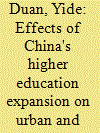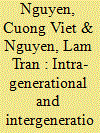| Srl | Item |
| 1 |
ID:
187851


|
|
|
|
|
| Summary/Abstract |
This study examines the heterogeneous effect of higher education on intergenerational mobility of rural and urban residents before and after China's higher education expansion (CHEE). Drawing on data from seven waves of the China General Social Survey (CGSS), we find that, although the overall effect of higher education decreases on alleviating intergenerational persistence after CHEE, undergraduate or postgraduate education can still significantly promote rural intergenerational mobility in terms of occupational-socioeconomic status. However, higher education appears to have changed from assisting social mobility to advancing intergenerational persistence in urban areas after CHEE. The propensity score matching method was used to mitigate sample selection bias, and all the findings were validated by several robustness checks, including placebo and Oster's (2019) omitted-variable tests.
|
|
|
|
|
|
|
|
|
|
|
|
|
|
|
|
| 2 |
ID:
147415


|
|
|
|
|
| Summary/Abstract |
This paper analyses the effects of innate ability, compulsory education (grades 1–9), and non-compulsory education (grades 10–12 and higher education) on inequality and intergenerational mobility of income, by constructing a four-period overlapping-generation model. We find that innate ability and family investment in early education play important roles in explaining income inequality and intergenerational income mobility. Though children from the wealthiest families are only 1.36 times ‘smarter’ that those from the poorest, the gap in human capital expands to 2.35 at the end of compulsory education and to 2.89 at the end of non-compulsory education. One important reason for the increase is that poor families invest relatively less in children's early education than do wealthy families; therefore, their children attend lower-quality schools, which results in them being much less likely to participate in higher education. By simulating policy experiments for different types of government education expenditure, we find that direct subsidies to poor parents are the most efficient and effective policy for mitigating poor families' budget constraints with regard to early-education investment in their children.
|
|
|
|
|
|
|
|
|
|
|
|
|
|
|
|
| 3 |
ID:
101087


|
|
|
|
|
| Publication |
2010.
|
| Summary/Abstract |
Disparities between social groups transcend the boundary of current generation and perpetuate across future generations as well. This is manifested as low intergenerational mobility in terms of both education and occupation in developing countries in general, and among specific ethnic groups within those countries in particular. This paper examines the extent of intergenerational mobility in both educational and occupational attainments for diverse social groups in India to understand the inertia of disparities prevalent. Results indicate strong intergenerational stickiness in both educational achievement and occupational distribution among the scheduled castes and tribes who have been discriminated against historically. Occupational mobility is lower than educational mobility indicating that educational progress is not being transformed to occupational improvement and bringing up the possibility of discrimination in the labour market. This also brings to the fore the fact that historical social exclusion has had a long-run effect and the inertia is quite strong.
|
|
|
|
|
|
|
|
|
|
|
|
|
|
|
|
| 4 |
ID:
173785


|
|
|
|
|
| Summary/Abstract |
This study examines intra-generational and intergenerational mobility of employment and income in Vietnam during the 2004–2014 period. It finds there was high mobility across occupations but less mobility across wage-job employment and economic sectors. Upward labour mobility increased over time because of the increase in skilled occupations. The intergenerational elasticity of earnings is estimated at around 0.36. Education plays an important role in increasing intra-generational as well as intergenerational mobility. The earning intergenerational elasticity for children with less than primary education is rather high, at 0.51, while this intergenerational elasticity for those with a college or university degree is much lower at 0.17.
|
|
|
|
|
|
|
|
|
|
|
|
|
|
|
|